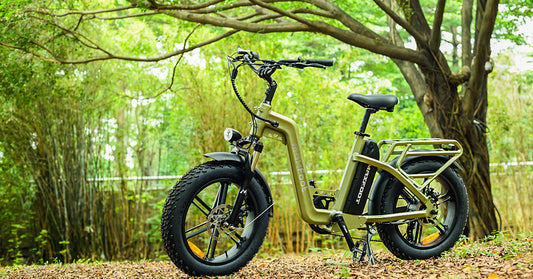Electric bicycles, have emerged as a compelling transportation alternative, bridging the gap between traditional cycling and motorized vehicles. By offering the advantages of pedal power combined with electric assistance, e-bikes appeal to a wide range of users, including commuters, leisure riders, and fitness enthusiasts.
A common question that arises when considering e-bikes is: how fast can they go? Well, that depends upon several factors such as motor power, load, design, and battery. Normal e-bikes can travel as higher as 20 mph while class 3 models can reach up to 28 mph. Higher-performance models may achieve even higher speeds.
Further, in this article, we will explore the factors that influence e-bike speed, and how various regulations and designs impact their performance on the road.
Understanding E-bike Classes
Before we delve into the specifics of e-bike speeds, it’s necessary to mention the classification system that governs these vehicles. In the United States, e-bikes are classified into three categories:
Class 1: Pedal-Assist with no throttle
These e-bikes have a motor that engages only when the rider is pedaling, and the electric assistance stops once the e-bike reaches 20 mph (32 km/h).
Class 2: Throttle-Assisted
Like Class 1 bikes, these bikes are also limited to a top speed of 20 mph (32 km/h), but they can be powered solely by the electric motor via a throttle, without the need for pedaling. This is the common and most popular category. Maxfoot e-bikes lie in this category.
Class 3: Speed Pedelecs
These e-bikes are capable of reaching speeds of up to 28 mph (45 km/h) with electric assistance. However, like Class 1 e-bikes, the motor only engages when the rider is pedaling. There are some throttle-assisted models as well.
Please note that different countries may have different classification systems and regulations for e-bikes, so always check your local laws to ensure compliance.
Factors Influencing E-bike Speed
Several factors affect how fast an e-bike can go, including motor power, battery capacity, bike design, load, and rider input. Let's take a closer look at each of these factors:
Motor Power
The power output of an e-bike's motor, measured in watts (W), is one of the most critical factors determining its speed. In general, a more powerful motor will allow for higher speeds.
Most e-bikes on the market today feature motors ranging from 500W to 1000W. For instance, our Maxfoot MF-19 is a 1000W folding electric bike.
Though they aren’t common, some high-performance e-bikes boast motors with even higher power outputs, reaching up to 10,000W.
Battery Capacity
The capacity of an e-bike's battery, measured in watt-hours (Wh), is another indirect factor affecting speed continuity.
A higher-capacity battery can provide more sustained power to the motor, allowing the e-bike to maintain higher speeds for more extended periods. However, a larger battery also adds weight to the bike, which may offset some of the benefits of increased capacity.
Bike Design
The design of an e-bike can significantly influence its top speed. Factors such as weight, aerodynamics, and gearing all play a role in how fast an e-bike can go. For example, a lightweight, aerodynamic e-bike with efficient gearing will typically have a higher top speed than a heavier, less aerodynamic model with suboptimal gearing.
Load
The vehicle load directly affects the speed. With a higher load, it is hard for an electric cycle to achieve higher speeds since its electrical motor will need some of the energy resisting that load and rest pushing it forward.
Rider Input
Finally, it's essential not to overlook the role of the rider in determining e-bike speed. Factors such as pedaling effort, riding technique, and terrain will all impact how fast an e-bike can go. Even on an e-bike with a powerful motor and large battery, a rider who doesn't contribute much pedaling effort or struggles with technique may not achieve the bike's full-speed potential.
How Fast Can E-bikes Go?
Now that we've explored the factors influencing e-bike speed let's answer the burning question: how fast can e-bikes go?
As mentioned earlier, e-bike speeds are primarily governed by their classification. In the United States, Class 1 and Class 2 e-bikes are limited to a top-assisted speed of 20 mph (32 km/h), while Class 3 e-bikes can reach up to 28 mph (45 km/h). However, these are just legally mandated maximums. Additionally, there are a few 10,000W high-performance bikes that can reach as high as 85 mph (137 km/h) in ideal road conditions.
For most casual riders and commuters, the top speed offered by Class 1 and Class 2 e-bikes is more than sufficient. However, more experienced riders or those looking for a high-performance option may be drawn to Class 3 e-bikes or custom-built models with even more powerful motors.
Safety Considerations When Riding Ebikes
As e-bikes become capable of reaching higher speeds, you should consider the safety implications of riding at these velocities.
When riding an e-bike, always ensure that you are wearing appropriate safety gear, including a helmet, gloves, and high-visibility clothing.
In addition, be aware of the traffic conditions and obey all local laws and regulations. Remember that e-bikes are still bicycles, and they must follow the same rules of the road as traditional bicycles.
Riding an e-bike at excessive speeds, especially in urban areas with heavy traffic and pedestrians, can be dangerous and may result in fines or legal penalties.
If you need comfort and safety, opt for full suspension folding electric bikes and ones with a hydraulic braking system.
Final Thoughts
E-bikes have come a long way in recent years, and their top speeds are continually pushing the boundaries of what's possible for electric bicycles. Legally these bikes can go as higher as 28 mph while high-performance ones can go beyond 60 mph.




